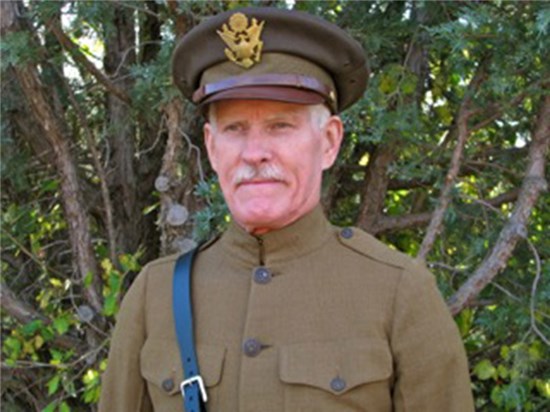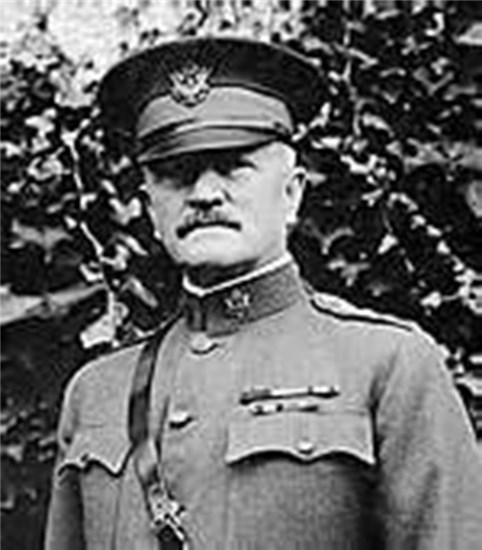

General John "Black Jack" Pershing (1860-1948)
By Ron Edgerton
Sponsored by Tointon Family Foundation
Essay
Jack Pershing seemed doomed to be late for everything. Born in Missouri in 1860, he came along too late to fight in the Civil War. Posted to New Mexico territory after graduating from West Point, he arrived a month after Geronimo’s surrender. Ordered to the Dakotas in 1890, he just missed the terrible Wounded Knee massacre. When the Spanish-American War broke out in 1898, he had hardly fired a shot in combat. But he had demonstrated uncommon leadership skills by organizing and drilling the award-winning Pershing Rifles at the University of Nebraska. He had also commanded a troop of Sioux Scouts and a unit of 10th Cavalry African-American soldiers, earning him the nickname “Black Jack.”
Black Jack Pershing led the same 10th Cavalry troops in Cuba. They fought gallantly in the Battle of Kettle Hill and San Juan Heights, only to watch Teddy Roosevelt and the Rough Riders claim all the glory. Not until four years later did he win fame as the great Moro fighter who pacified Philippine Moslems in the Philippine-American War. The next year this dashing bachelor met Helen Frances Warren (Frankie), daughter of Wyoming Senator Francis Warren, Chair of the Senate Military Affairs Committee. Thanks to President Roosevelt’s strong recommendation and Senator Warren’s endorsement, he gained promotion from Captain to Brigadier General in 1906, jumping over 862 higher ranked officers in the process.
There followed two more tours in the Philippines, the last as military Governor of Moro Province. Not long after his return to the U.S., terrible tragedy befell his family when in 1915 Frankie and their three young daughters died in a house fire in San Francisco. Only son Warren survived, and the tragedy haunted Pershing for the rest of his life.
After burying Frankie and his daughters in Cheyenne, Jack accepted command of America’s punitive expedition against the elusive Pancho Villa in northern Mexico. Although, the expedition met with mixed results, Pershing proved himself to be a tough, decisive and relentless military leader. When the United States entered World War I in 1917, President Wilson appointed him Commander of the American Expeditionary Forces in France. Elements of that great army of over 2,000,000 men fought at Cantigny, Chateau-Thierry and Belleau Wood, at St. Mihiel, and finally in the greatest battle of American military history, the Meuse-Argonne Offensive. Pershing returned home at war’s end a national hero.
Like Generals Washington, Jackson, Taylor and Grant before him, General Pershing seemed primed to become President of the United States. But politics and Pershing did not mix. He couldn’t even beat Warren Harding for the Republican Party’s nomination in 1920. Instead, he served as Chief of Staff from 1921 to 1924. More than any other man, he modeled what it meant to be a modern American military officer. Upon retirement, he wrote extensively and was still editing his memoirs when he died on July 15, 1948.
Recommended Reading
Pershing, John J. My Experiences in the World War. 2 vols. Frederick A. Stokes, 1931.
Smythe, Donald. Pershing, General of the Armies. Indiana University Press, 1986.
Vandiver, Frank E. Black Jack, The Life and Times of John J. Pershing. 2 vols. Texas A&M University Press, 1977.
Walker, William. Betrayal at Little Gibraltar. Scribner, 2016.
Woodward, David R. The American Army and the First World War. Cambridge University Press, 2014.
Yockelson, Mitchell. Forty-Seven Days, How Pershing’s Warriors Came of Age to Defeat the German Army in World War I. New American Library, 2016.
Ron Edgerton
In 1973 Ron Edgerton arrived in Greeley with his family (Becky, Kate & Jeremy) as a young Professor of Asian History at UNC. He had become interested in Asia as a Peace Corps Volunteer in the Philippines. Between 1985 and 2000 he directed UNC’s Honors Program while also teaching courses in Asian History and the Life of the Mind Program. After Becky’s death, he met and happily married Thelma Bear Edgerton. He and Thelma have been Chautauqua volunteers for many years. Ron is completing a book on Jack Pershing and America’s first military encounter with militant Islam – the Moro War in the Philippines, 1900-1914.
Bullet Points
General Pershing was Supreme Commander of the American Expeditionary Forces in World War I.
More than any other man, John J. Pershing became the face of the U.S. Army in the early 20th century. He modeled what it meant to be a modern American military officer: dignified, direct, iron willed, decisive, tireless, and determined. He radiated “presence.”
Pershing took seriously the West Point motto: “Duty, Honor, Country.” He remained true to this motto throughout his life.
Pershing also had a “human” side, although he made little effort to show this side in public. He adored his wife and children, had a good sense of humor and hearty laugh, enjoyed telling stories (even on himself), liked few things more than good conversation, loved ballroom dancing, and could be very charming when he wanted to be.
In accordance with his wishes, Pershing was buried in the World War I section of Arlington Cemetery with a simple headstone no different than the grave markers of the men he had commanded.
Quotes
Pershing’s most famous quote is actually something that he never said. In Paris on July 4, 1917, he is supposed to have told the French people: “Lafayette, We are Here!” Actually, Pershing had asked Col. E. E. Stanton to make formal remarks at the ceremony, and it was Stanton who spoke these words.
“Pegler, get the hell out of my office!” Spoken to famous journalist Westbrook Pegler who barged into Pershing’s office one day in 1918, asking for an interview.
“I can say with all sincerity that nothing gives me more happiness than that I have never been drawn into political life.”
“Was anybody else in the war?” Pershing’s question after listening to General Douglas MacArthur carry on about his exploits in World War II.
Pershing believed that the November 11, 1918 armistice was a major blunder. He said: “What I dread is that Germany doesn’t know that she was licked.” Less than two decades later, Adolf Hitler argued that, indeed, Germany had not been defeated.
“More than half the world is ruled by men who despise the American idea and have sworn to destroy it. They know that while one great people remains independent and free because it is strong and is brave, they can never crush finally the people they have conquered.” Radio Address, Aug. 4, 1940.
Timeline
1860 - John Joseph Pershing born in Laclede, Missouri
1886 - Graduates as Senior Captain, Corps of Cadets, West Point
1886-90 - Posted to New Mexico
1891 - Takes charge of Company of Sioux Scouts, North Dakota
1891-95 - Professor of Military Science & Tactics, University of Nebraska, Lincoln. His drill team (the Pershing Rifles) wins first place in the nation. He earns his law degree.
1895-96 - Commands Troup D, 10th Cavalry (African-American) in Montana.
1897 - Instructor in Tactics, West Point
1898 - Fights with 10th Cavalry at Kettle Hill & San Juan Heights
1899-1903 - Posted to the Philippine Islands where he gains fame commanding American troops vs. Maranao Moros in Mindanao.
1905 - Marries Helen Frances (Frankie) Warren
1905 - Posted to Tokyo as Russo-Japanese War observer
1906 - Promoted from Captain to Brigadier General
1906-08 - Commands American Base at Ft. McKinley, Manila
1909-13 - Military Governor of Moro Province
1915 - Frankie, Helen, Anne & Mary Margaret killed in house fire at the Presidio. Son Warren escapes.
1916-17 - Leads American Punitive Expedition vs. Pancho Villa.
1917 - Appointed Commander of AEF
1917-18 - Leads American Expeditionary Forces in France.
1921-24 - Chief of Staff, American Army
1932 - Wins Pulitzer Prize for My Experiences in the World War.
1920s & 30s - Heads American Battle Monuments Commission
1948 - Death in Washington, D.C. 300,000 line streets for funeral procession to Arlington Cemetery.